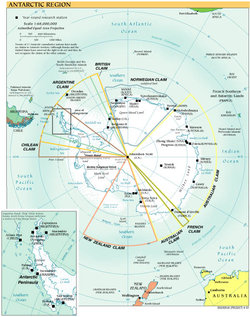Antarctic Treaty System
|
|
- For the Antarctic Treaty from the Gundam anime, see Antarctic Treaty (Gundam)
Antarc-flag2.gif
The Antarctic Treaty and related agreements, collectively called the Antarctic Treaty System or ATS, regulate the international relations with respect to Antarctica, Earth's only uninhabited continent. For the purposes of the treaty system, Antarctica is defined as all land and ice shelves south of the southern 60th parallel. The treaty was signed by 12 countries, including the United States and the Soviet Union, and set aside Antarctica as a scientific preserve and banned military activity on that continent. This was the first arms control agreement established during the Cold War.
The Antarctic Treaty System
- Antarctic Treaty
- Agreed Measures for the Conservation of Antarctic Fauna and Flora (1964) (entered into force in 1982)
- The Convention for the Conservation of Antarctic Seals (1972)
- The Convention for the Conservation of Antarctic Marine Living Resources (1980)
- The Convention on the Regulation of Antarctic Mineral Resource Activities (1988) (never entered into force)
- The Protocol on Environmental Protection to the Antarctic Treaty (1991)
The main treaty was opened for signature on December 1, 1959, and officially entered into force on June 23, 1961. The original signatories were the 12 countries active in Antarctica during the International Geophysical Year of 1957-58 and willing to accept a US invitation to the conference at which the treaty was negotiated. These countries were Argentina, Australia, Belgium, Chile, France, Japan, New Zealand, Norway, South Africa, the U.S.S.R., the United Kingdom and the United States of America (which opened the Amundsen-Scott South Pole Station for the International Geophysical Year).
The main objective of the ATS is to ensure in the interests of all mankind that Antarctica shall continue forever to be used exclusively for peaceful purposes and shall not become the scene or object of international discord. The treaty forbids any measures of a military nature, but not the presence of military personnel per se. It also defers the question of territorial claims asserted by some nations and not recognized by others.
The Antarctic Treaty System's yearly Consultative Meetings are the international forum for management of the region. Only 27 of the 44 parties to the agreements have the right to participate in these meetings. These parties are the Consultative Parties and, in addition to the twelve original signatories, include 15 countries that have demonstrated their interest in Antarctica by carrying out substantial scientific activity there. These additional countries are Brazil, Bulgaria, the People's Republic of China, Ecuador, Finland, Germany, India, Italy, South Korea, Netherlands, Peru, Poland, Spain, Sweden and Uruguay.
The 17 Non-Consultative Parties are Austria, Canada, Colombia, Cuba, the Czech Republic, Denmark, Greece, Guatemala, Hungary, North Korea, Papua New Guinea, Romania, Slovakia, Switzerland, Turkey, Ukraine and Venezuela.
See also: Government of Antarctica, Environmental agreements
External links
- Full Text of the Antarctic Treaty (http://www.nsf.gov/od/opp/antarct/anttrty.jsp)de:Antarktisches Vertragssystem
es:Tratado Antártico fr:Traité_sur_l'Antarctique ja:南極条約 nl:Antarctisch Verdrag no:Antarktis-traktaten pl:Traktat Antarktyczny pt:Tratado da Antártida

